Alex Bledsoe's Blog, page 5
February 13, 2018
What are fairies?
This is adapted from a presentation I gave at the 2017 Pagan Unity Festival.
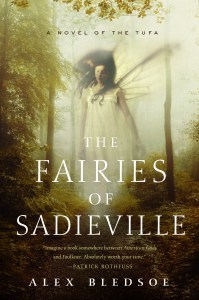 If you’re here reading this, you probably already know that my Tufa novels are about a race of exiled fairy folk in the mountains of east Tennessee. The title of the sixth and final book in the series, The Fairies of Sadieville, explicitly references this connection. And although they’re entirely fictional, they draw on fairy folklore and address some of the fundamental questions about fairy belief.
If you’re here reading this, you probably already know that my Tufa novels are about a race of exiled fairy folk in the mountains of east Tennessee. The title of the sixth and final book in the series, The Fairies of Sadieville, explicitly references this connection. And although they’re entirely fictional, they draw on fairy folklore and address some of the fundamental questions about fairy belief.
So, are fairies real? Do they have their own independent existence? It depends on what we think they are.
Are they the dead?
C.S. Lewis, in The Discarded File: An Introduction to Medieval and Renaissance Literature, says, “The identity, or close connection between the fairies and the dead was certainly believed in, for witches confessed to seeing the dead among the fairies.”
There are many ways the beliefs in fairies and the dead coincide.
Carole B. Silver, in Strange and Secret Peoples: Fairies and Victorian Consciousness, points out that it’s dangerous to eat food in both Fairyland and Hades, and both the dead and fairies live underground.
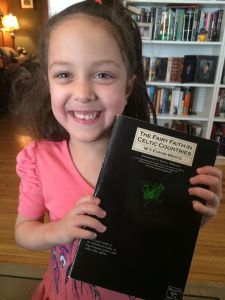 In The Fairy Faith in Celtic Countries, W.Y. Evans Wentz says, “Ancestral worship must be held to play a very important part in the complex Fairy-Faith as a whole.
In The Fairy Faith in Celtic Countries, W.Y. Evans Wentz says, “Ancestral worship must be held to play a very important part in the complex Fairy-Faith as a whole.
“Samain, as we already know, was the great Celtic feast of the dead when offerings or sacrifice of various kinds were made to ancestral spirits, and to the Tuatha De Danann and the spirit-hosts under their control; and Beltane, or the first of May, was another day anciently dedicated to fetes in honour of the dead and fairies.”
Are they supernatural?
C.S. Lewis, again, says, “If we call them ‘supernatural,’ we must be clear what we mean. Their life is, in one sense, more ‘natural’—stronger, more reckless, less inhibited, more triumphantly and impenitently passionate—than ours. They are liberated both from the beast’s perpetual slavery to nutrition, self-protection and procreation, and also from the responsibilities, shames, scruples and melancholy of Man.”
 Robert Kirk, in The Secret Common-Wealth of Elves, Fauns and Fairies, adds, “[They] are of a middle nature between Man and Angel, as were Daemons thought to be of old.”
Robert Kirk, in The Secret Common-Wealth of Elves, Fauns and Fairies, adds, “[They] are of a middle nature between Man and Angel, as were Daemons thought to be of old.”
Are they physical beings, another race or species?
Tuatha de Danaan means “Children of Dana,” also known as “Danu.” According to Charles Squire in Celtic Myths and Legends, Danu is a mother goddess in Celtic mythology, who goes so far back there are no reliable texts or oral traditions about her. She has been compared to the Greek goddess Demeter, and therefore is assumed to have been a mother goddess.
The Tuatha de Danaan came to Ireland, lived for a time, and were finally defeated in battle. In dividing up the land between his victorious forces and the Tuatha de Danaan, the winning side’s king cleverly gave the above-ground to his own people, and the below-ground to the Tuatha de Danaan. Thus they live beneath the fairy mounds.
The discovery of ancient hominids of small stature on the island of Flores, who co-existed with modern humans for a substantial amount of time, makes it possible that the initial impetus for the belief in fairies might have been an actual, physical race.
Many believe that the Picts of Scotland were a physically small race, and their mysteries may have been the origin of the fairies.
Are they aliens?
Thomas Rapsas observes, “There’s a parallel between those who claim to have witnessed angels or the divine, and those who see aliens and fairies. These entities often appear out of nowhere and disappear just as quickly. They defy rationale or scientific explanation. Yet to the people who witness them, they are as real as you and I, and seem to represent first-hand proof that there is more to this world than meets the eye.”
If you accept that all three phenomena are entirely within the mind of the one experiencing them, then it makes sense that they would be conjured out of the society around them.
What do you think?
Coming soon: the nature of fairy life.
February 5, 2018
On Themes and the Tufa, Part 2
See part 1 here.
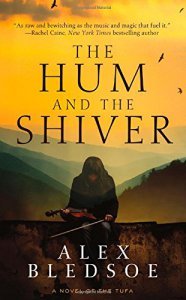 When The Hum and the Shiver proved successful enough to warrant a sequel, I wanted to advance the themes as well as the story. I decided that the central recurring character would be the place, not Bronwyn Hyatt. Cloud County and Needsville held many other characters I felt could (and subsequently did) carry their own novels.
When The Hum and the Shiver proved successful enough to warrant a sequel, I wanted to advance the themes as well as the story. I decided that the central recurring character would be the place, not Bronwyn Hyatt. Cloud County and Needsville held many other characters I felt could (and subsequently did) carry their own novels.
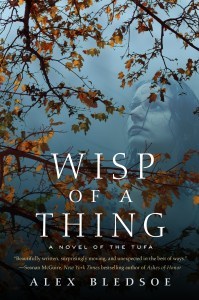 I’ve said elsewhere that Wisp of a Thing was actually the Tufa novel I wrote first, in which I worked out the world, its rules, and many of the characters. That version of the story bears only the slightest relationship to the final book, though, and it turns out that changing a prequel into a sequel is actually more work than writing a new book from scratch.
I’ve said elsewhere that Wisp of a Thing was actually the Tufa novel I wrote first, in which I worked out the world, its rules, and many of the characters. That version of the story bears only the slightest relationship to the final book, though, and it turns out that changing a prequel into a sequel is actually more work than writing a new book from scratch.
The final version of Wisp involves a different set of main characters; Bronwyn is present, but in a supporting role. It was also at this point that I started thinking about the overall theme of the series, a kind of guiding philosophy that can be boiled down to one question:
What happens when you’ve hidden forever from the world, but now you can no longer hide?
The recurring figure of the outsider protagonist first appears here. Craig filled that role in The Hum and the Shiver, and to a certain extent so did Don Swayback. But now the story follows true outsider Rob Quillen, and we see the Tufa through his eyes, learning about them as he does. He embodies that overall theme, forcing aspects of the Tufa into the light, while the book has its own sub-theme, best phrased by William Faulkner* in Requiem for a Nun: “The past is never dead. It’s not even past.”**
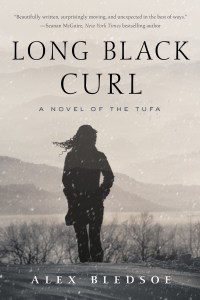 In Long Black Curl, the outsiders are exiled Tufas Bo-Kate Wisby and Jeff Powell. Separated from their culture, they’ve made their way in the regular world for decades, using their faerie glamour to keep anyone from noticing. Bo-Kate is bent on vengeance, and her primary tool is rockabilly singer Byron Harley. All three view the current Tufa hierarchy with suspicion and disdain, seeing only the worst (and not being entirely wrong). The book’s theme is a variation on The Hum and the Shiver: Can you forgive what’s happened in order to move forward? And if not, what then?
In Long Black Curl, the outsiders are exiled Tufas Bo-Kate Wisby and Jeff Powell. Separated from their culture, they’ve made their way in the regular world for decades, using their faerie glamour to keep anyone from noticing. Bo-Kate is bent on vengeance, and her primary tool is rockabilly singer Byron Harley. All three view the current Tufa hierarchy with suspicion and disdain, seeing only the worst (and not being entirely wrong). The book’s theme is a variation on The Hum and the Shiver: Can you forgive what’s happened in order to move forward? And if not, what then?
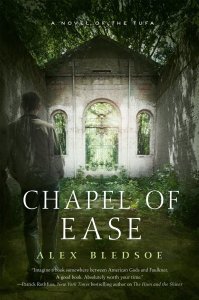
Chapel of Ease uses a very different outside perspective; it’s told entirely from the first-person perspective of Matt Johansson, a gay New York actor. He learns about the Tufa first from a play he’s in, written by Tufa playwright Ray Parrish, who dies mysteriously the night before it opens. This makes the series theme explicit: by sharing a Tufa secret with the world, Ray pushes them even more into the light. Their time hiding is quickly coming to an end. The novel itself is about the value of secrets, and what gives them their power.
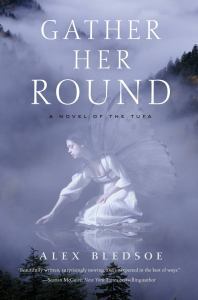 Gather Her Round is, on the surface, a monster story. It’s also about characters who simply can’t resist their own worst impulses. It’s the novel most grounded in the Tufa world; by this point, I felt it was safe to assume readers no longer needed the mystery of the Tufa’s true nature. But there is an outsider: Jack Cates, a game warden charged with tracking down the monster. The very ease of his entry into this formerly closed and sealed society demonstrates how far the Tufa have come since Craig tried to make friends in The Hum and the Shiver.
Gather Her Round is, on the surface, a monster story. It’s also about characters who simply can’t resist their own worst impulses. It’s the novel most grounded in the Tufa world; by this point, I felt it was safe to assume readers no longer needed the mystery of the Tufa’s true nature. But there is an outsider: Jack Cates, a game warden charged with tracking down the monster. The very ease of his entry into this formerly closed and sealed society demonstrates how far the Tufa have come since Craig tried to make friends in The Hum and the Shiver.
 And that brings us to The Fairies of Sadieville, the upcoming final Tufa novel, available April 10, 2018. As with its predecessors, this novel can be read as a stand-alone; but more so than the others, there are treats and surprises for readers who have been on this journey with me. It brings a lot of the thematic threads together for a conclusion that, I hope, satisfies both the casual reader and the fan who’s stuck with me all along.
And that brings us to The Fairies of Sadieville, the upcoming final Tufa novel, available April 10, 2018. As with its predecessors, this novel can be read as a stand-alone; but more so than the others, there are treats and surprises for readers who have been on this journey with me. It brings a lot of the thematic threads together for a conclusion that, I hope, satisfies both the casual reader and the fan who’s stuck with me all along.
As I said in my prior post, usually I have no idea what the theme of a book will be until I’m pretty far into revision. Even then, what I intend as the theme (and this is true of any writer’s work) may not be what readers get from it. And that’s okay; it means the story lives for the reader, and that they’re engaged with it in a very active way.
###
*Yes, Faulkner’s famous fictional Mississippi county of Yoknapatawpha influenced my creation of Cloud County; specifically, it gave me the courage to invent my locale, rather than trying to wedge my otherworldly faerie folk into a real place, as I’d done with vampires and Memphis.
**If you’re unaware, this particular line was the subject of a 2013 copyright dispute between Faulkner’s estate and the Woody Allen film Midnight in Paris. The estate lost; you can read about the case here.
January 23, 2018
On Themes and the Tufa, Part 1
When I wrote the first Tufa novel, The Hum and the Shiver, I had no plans for a series. I wrote it on spec, without a contract, just prior to the release of my first novel, The Sword-Edged Blonde.
In that first Tufa book, I had a very particular, self-contained story in mind: circumstances force Bronwyn Hyatt to decide how much she wants to step into her predetermined role in the Tufa community, and how much she wants to go her own way. That decision defines her character.
Bronwyn’s story thread is echoed by Craig Chess, a young Methodist minister also trying to find a balance between his calling and his own sense of morality. Craig wants to share Christ’s love and hope with the Tufa, who have a history of resisting exactly that; in fact, there’s no church of any kind in Cloud County (it turns out there’s the remains of one, as the title of the fourth book, Chapel of Ease, reveals). He’s perceptive enough to understand that he’ll never win them over by proselytizing, so instead he simply behaves as he believes Christ would: he’s compassionate, supportive, and helpful to the Tufa without asking anything in return.
A third thread involves reporter Don Swayback, only part Tufa, who has ignored and resisted that aspect of his heritage but finally decides to embrace it. Together, these stories form the thematic line that runs through the book: the struggle between responsibility and freedom.
How did I decide on this theme? Let me use an example from another art form.
In Bruce Springsteen’s VH1 Storytellers episode, Bruce goes into detail about the song “Devils and Dust,” explaining how each line and image works toward the song’s final effect. But then he says:
“How much of this was I thinking about when I wrote the song? None of it. How much of that was I feeling when I wrote the song? All of it.”

And that’s usually the truth. Artists—in the general sense of those who make any form of art—often don’t have a clue what their works mean, we just know when it feels right. When I started writing The Hum and the Shiver, I had no advance intent of making Craig’s story reflect and comment on Bronwyn’s. I wanted a minister character because, in a novel about the South, it just felt right.
Which is not to say the final thematic form isn’t deliberate. For me, the themes start to emerge during revision. You notice that some elements, with a little tweaking, can provide interesting counterpoints to others. You see that characters behave in ways that subtly comment on things. You realize that the speech you gave your hero explaining what you meant can be shown rather than told through action and plot. You see the forest and the trees.
Experience has taught me that anyone can write, i.e., string words together with some sort of coherence. The skill and inspiration that makes a real writer, though, show up in revisions. The ability to shape your story into something more meaningful than a mere pile of words is the center of the Venn diagram of art, skill, and inspiration.
Coming soon: how the themes of this book expanded to become the overall themes of the series.
January 11, 2018
An announcement about The Fairies of Sadieville
As I’ve said before, every book in a series is a balancing act between giving readers something new, and giving them what they already love. We’ve all read series that over time seemed unable to do the former and settled for repeating the latter. It’s common to say, “That series should’ve ended back at ,” which is the point that, in retrospect, it’s obvious the author fell back on that repetition. By the time they peter out, only the hardcore fans remain.
There’s also the unfortunate case of authors who pass away before concluding a series. Robert Jordan is probably the best known example in fantasy, leaving the final book in his Wheel of Time series unfinished at the time of his death (Brandon Sanderson completed it). Recently Sue Grafton, author of the popular Kinsey Millhouse “alphabet” series, died with Y is for Yesterday done, but not the final “Z” volume. In her case, there will be no Z; as her family said, “as far as we are concerned, the alphabet now ends at Y.”
So it’s the lucky writer who gets to bring his series to some kind of conclusion that lets him tie up the threads he’s been weaving since the first book. And hopefully, that means the reader is lucky, too.
All this is by way of saying that The Fairies of Sadieville will be the final Tufa novel.
Please don’t be sad about this, because it means I’m one of those lucky writers. It’s not that I don’t have more ideas; rather, the ideas I have don’t go anywhere new. If I did continue, there’s the danger I might start repeating myself out of desperation, or laziness, or both. What I’ve tried to make compelling and unique might degenerate into soap opera. What I’d hoped was magical and delicate might become trite and obvious. So I’ve decided to end it now with a story that fills in a lot of the blanks I’ve hinted at in the prior books, and in the process wraps up the various subplots running throughout the series.
When Sadieville comes out in April (pre-order from all the usual suspects here), I hope the readers who have followed the Tufa since The Hum and the Shiver in 2011 feel like it’s an appropriate finale. After all, you’re the ones who got me this far.
And for all those who don’t start a series until the last book is out . . . now’s the time to jump right in! There’s a special deal on the series so far, including the short stories, right here.

October 3, 2017
Ten years after The Sword-Edged Blonde
Ten years ago this week, a lifelong dream finally came true. My first novel, The Sword-Edged Blonde, came out in hardcover. It introduced both me, and my character Eddie LaCrosse, who has gone on to feature in four more novels and a smattering of short stories.
Although the manuscript that became Wisp of a Thing was the one that induced my agent, Marlene Stringer, to take a chance on me, she sold The Sword-Edged Blonde first. As a newbie, I was more resistant to editorial suggestion than I am now. For all I knew, this would be my one and only book, and I had to make sure it was right. I naively insisted on the “purity of my vision” and ignored Marlene’s sensible advice (I have since apologized for that, and now pretty much take all her suggestions). Thanks, Marlene!
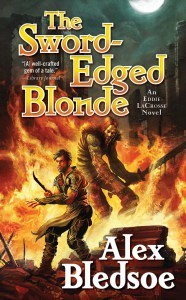
The mass-market paperback, cover art by Jean-Sebastien Rossbach.
It was appropriate that The Sword-Edged Blonde was my first published novel, too. It began as an idea I had when I was eighteen and in high school, as a way to impress a beautiful girl. Of course, I never actually showed it to her, and she was actually a teacher, so it wouldn’t have worked anyway. Still, it stayed with me, going through many permutations (the hero’s first name was originally “Devaraux,” for example. Yeah, yeah, I know) before it became the story as it now stands. And when it came out, I finally told that teacher how she’d inspired it, and dedicated the book to her.
I went through all the usual first-novel traumas. With no idea of how to deal with editors, I was cowed and compliant; their issues were minor, thank goodness, because that close to being published, I’m pretty sure I would’ve gone along with anything they suggested. One thing they did insist on was a new title: the manuscript sold under the simple title Rhiannon, since the Fleetwood Mac song was a big influence on the mood. I drew up a short list of alternates, and everyone agreed The Sword-Edged Blonde was it. It combined fantasy and noir, and gave readers a big hint about what they’d be getting.
When it came time to get those all-important cover blurbs, I knew immediately whose opinion I would want: Charles de Lint. He needs no introduction here, and when I wrote to ask him, he graciously agreed to read it, and even more graciously provided a blurb (fun fact: ten years later, I provided a blurb for his book, The Wind in His Heart). There are cooler things than one of your favorite living authors saying he likes your stuff, I suppose. But not many. Thanks again, Charles!
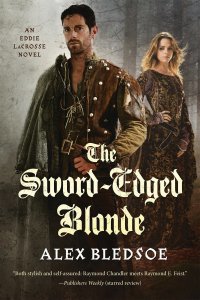
The trade paperback edition, art by Larry Rostant
Speaking of covers, as much as I liked the original cover art by Justin Sweet, which did depict an actual scene from the story (that’s more rare than you’d think), it bugged me that it got all the details wrong. There were no Mongol warriors in the story, the girl in the scene was not the titular blonde, and to this day, I wonder what inspired Eddie’s harlequin pants.
And a big surprise on the cover was that my name—a total unknown, remember—was as large as the title. That can be awfully intimidating when you’re just starting out.
I was lucky enough to get a starred review in Publishers Weekly, one of the big three in mainstream reviewing. If there’s anything that’ll stir your blood as a newbie, it’s getting validation for something you’ve carried in your head and heart for a long time. And most of the other reviews were positive.
And The Sword-Edged Blonde was also my first experience with Blackstone Audio, and the wonderful Stefan Rudnicki, who has since read all my books for audio.
 So happy tenth, SEB. And for all you other writers struggling with rejection and despair, here’s another fun fact: as I said, I had the idea for this book when I was 18. I was 44 when it came out. That’s a little over a quarter century. So just because it doesn’t happen right away, doesn’t mean it won’t happen. Keep writing, keep submitting, and remember that the only people guaranteed to fail are the ones who quit.
So happy tenth, SEB. And for all you other writers struggling with rejection and despair, here’s another fun fact: as I said, I had the idea for this book when I was 18. I was 44 when it came out. That’s a little over a quarter century. So just because it doesn’t happen right away, doesn’t mean it won’t happen. Keep writing, keep submitting, and remember that the only people guaranteed to fail are the ones who quit.
August 28, 2017
Tobe Hooper: the Kids and the Chainsaw
The recent death of director Tobe Hooper has me, and millions of others, thinking about his landmark third film, The Texas Chainsaw Massacre.
In 1974, Massacre presented three major innovations. One, it was both set and made in Texas, and wore its non-Hollywood pedigree on its bloody, tattered sleeve. Two, it was (or seemed to be, which I’ll get to) gratuitously violent in ways that just weren’t common at the time (Herschel Gordon Lewis was the closest, and he was far from mainstream). And three, the topic I want to address here, it introduced the idea of “a group of teenage friends” to horror, an idea that still haunts (not in a good way) the genre today.

Yes, these are supposed to be teenagers, not thirty-year-old accountants on their day off. Welcome to the Fifties.
There have always been teenagers in horror and scifi; one look at a list of typical Fifties drive-in fare establishes that. But those teens were also kept locked in the Puritanical mores of the Production Code: they were chaste teetotalers, about as much fun to hang out with as those missionaries who ring your doorbell at dinner, and if they were delinquents, it was because they were misunderstood. They were, in other words, the teens your parents wanted you to be. But Hooper and cowriter Kim Henkel took their teens not from prior horror films, but from the movies that followed in the wake of Easy Rider. These were sexually active, drinking, drug-taking teens; in other words, figures of real identification to 70s youth.

Not the clean-cut, clear-eyed teens of the fifties by a long shot.
And yet there’s one other aspect to this choice, one that I haven’t seen discussed much when the film is brought up. Simply, these “kids” (for lack of a better word) are blanks. There are names, and and some basic history, but ultimately they just don’t register as characters. Which is okay, because this movie isn’t interested in horror or suspense. It’s selling sadism.
Consider the famous scene in which Pam (Teri McMinn) is impaled on a meathook and slowly writhes there while Leatherface carves up her boyfriend. The horror here doesn’t come from gore (the budget was too low for real effects), or suspense (everything either happens so fast it barely registers, or goes on and on as we watch). It comes from the sadistic pleasure of watching this character suffer, while another character is treated like a literal piece of meat. Do they deserve it? Who knows? If they did, we might be entirely on the side of the villains, and if they didn’t, the scene could easily become unbearable (which is almost does anyway).
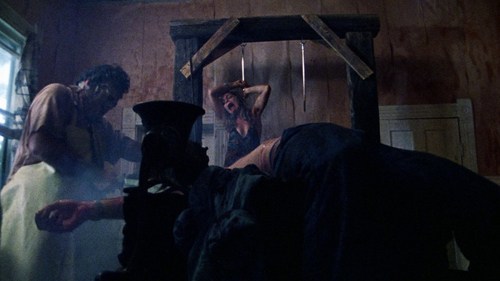
Pam on the meat hook.
But we don’t particularly care about Kim, Kirk, wheelchair-bound Franklin or his sister (and final girl) Sally, because as I said, they’re blanks. Neither do we “care” for Leatherface and his extended, grotesque family. It’s like watching a car wreck, in the best possible sense: we’re not threatened, but we are aghast at the blood and gore, and our emotional involvement extends only to being thankful that it’s not us.
This is not a criticism, by the way. Faced with the logistics of making a low-budget film far from Hollywood, with a crew of locals and beginning actors, Hooper and company played to their strengths. The Texas heat is palpable, and you can almost smell some of the scenes. The gore might not be seen, but it’s implied so intensely that many people think it’s an incredibly gory film. And the actors walk the superfine line between performance and simply being, so that when they start dying we can watch the car wreck as it unfolds, and have the experience Hooper clearly meant for us to have.
Unfortunately, many lesser filmmakers, to this day, have taken the wrong lesson from this. When I look at a horror film synopsis and it begins with, “A group of college friends…” or “A group of partying teens…” or any variation of that, I move on. Experience has taught me that these “everyday” kids will be obnoxious “movie” teens whose order of demise can probably be predicted before the opening credits finish. They’re not characters any more than they were for Hooper, but they’re also not in the service of anyone with a vision or even a fresh idea.* They’re a cynical attempt to connect with the “youth market,” then as now the primary consumers of horror.
We wouldn’t have the modern slasher genre without Tobe Hooper, and it’s certainly not his fault that it became the dreck it did a mere decade later. Hooper himself certainly moved on to bigger budgets and ideas. But there’s a primal power in his breakthrough film, one that everyone who sees it feels. It’s a deliberate car wreck designed by an artist.
*A glorious exception: Tucker and Dale Versus Evil, which flips all the standard tropes.
August 14, 2017
Reader Question: Writing from a Woman’s POV
Reader Jane Payne (a name I just may borrow for a character) asked on my Facebook author page: “Writing POV for female characters. You do well! Is it challenging?”
First, thank you for the compliment. I appreciate that a lot.
Is it challenging? I can’t deny that it was at first, mainly because I expected it to be. We’re taught to write what we know*, and at first it’s easy to believe there’s simply no way for a man to truly know what it feels like to be a woman. Not just in society, but in emotions, behavior, anything. All of us are limited to our own perspectives, and that’s bundled with our gender identity, our life experiences, our intelligence, and all the other things that make us individuals. The more differences we have with other people, the harder it is to imagine ourselves in their shoes, right?
But luckily, our brains have evolved one of the greatest tools for both living, and writing: empathy. Writers in particular have to cultivate this, because otherwise, we’re just creating autobiography.
 The protagonist of my first Tufa novel, The Hum and the Shiver, is one of my favorite characters: ex-soldier and ex-wild girl Bronwyn Hyatt. Filled with contradictory emotions, torn between the past and the future, between tradition and her own path, she has to navigate both the world around her and the raging one inside of her own head.
The protagonist of my first Tufa novel, The Hum and the Shiver, is one of my favorite characters: ex-soldier and ex-wild girl Bronwyn Hyatt. Filled with contradictory emotions, torn between the past and the future, between tradition and her own path, she has to navigate both the world around her and the raging one inside of her own head.
Bronwyn was inspired by, but not based on, the experiences of Jessica Lynch in the first Gulf War. My idea: what if, instead of going back to a small West Virginia town, a brave young soldier had to go back to a supernatural community that expected way too much from her? As I worked on it, I was also guided by a line I recalled from a review of the film Tender Mercies, in which the main character, a washed-up country singer, was described as someone who “comes back, but only as far as he wants to.”
Those ideas gave me her character arc, but there was no way to write about her without crawling inside her head, talking about her feelings and doubts and concerns.
So how did I do it?
 As with so many things, I had to learn to just get out of my own way. Yes, Bronwyn Hyatt is a woman, but she’s also a very specific human being, regardless of gender or sexual role. When I stopped worrying about writing a “woman,” and started concentrating on writing this person, it became much easier. If there is a secret to writing from another perspective, it’s that. Stop thinking about the labels, and concentrate on just getting that person down on paper
(this lesson also served me well with the protagonist of Chapel of Ease, a gay man written in first person).
As with so many things, I had to learn to just get out of my own way. Yes, Bronwyn Hyatt is a woman, but she’s also a very specific human being, regardless of gender or sexual role. When I stopped worrying about writing a “woman,” and started concentrating on writing this person, it became much easier. If there is a secret to writing from another perspective, it’s that. Stop thinking about the labels, and concentrate on just getting that person down on paper
(this lesson also served me well with the protagonist of Chapel of Ease, a gay man written in first person).
Did I get it right? It’s not my place to say. Only readers can do that.
Thanks for the question, Jane!
* I’ve been a professional writer for 10+ years, and was an aspiring one for many years before that; I can say with no reservations that this is the worst writing advice ever.
August 8, 2017
Edit Disasters Addendum: When It All Goes Right
This is a quick addendum to yesterday’s blog post about editing disasters, to show you an example of when things go right.
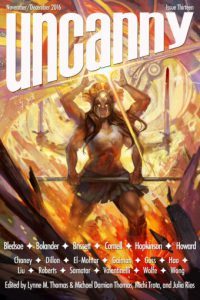 Recently I sold the short story “White Hart, Black Knight,” to Uncanny Magazine. It’s a story about my character Eddie LaCrosse, inspired by an Arthurian tale of Sir Gawain. When I turned it in, the editor very astutely pointed out that all the characters but one were men, and the lone female character went unnamed. This was true to the Medieval source material, but since I was writing neither a history nor an actual Arthurian story, I was certainly not bound by it. The editor suggested not only naming that previously nameless character, but changing some of the others to women, to create a more balanced and inclusive world.
Recently I sold the short story “White Hart, Black Knight,” to Uncanny Magazine. It’s a story about my character Eddie LaCrosse, inspired by an Arthurian tale of Sir Gawain. When I turned it in, the editor very astutely pointed out that all the characters but one were men, and the lone female character went unnamed. This was true to the Medieval source material, but since I was writing neither a history nor an actual Arthurian story, I was certainly not bound by it. The editor suggested not only naming that previously nameless character, but changing some of the others to women, to create a more balanced and inclusive world.
Author/filmmaker Nicholas Meyer is fond of saying, “Art thrives on restriction,” and I believe that’s true. Set boundaries, and you’re forced to be creative within them. In this case, those “boundaries” were the editorial suggestion, which actually opened the story up in new ways. My frankly generic king became a far more interesting queen, and one of my two valiant brother knights became an equally valiant sister knight. As a result, the story’s world became more interesting, truer to the egalitarian spirit of the Eddie LaCrosse novels, and just plain better overall.
(However, neither the editor nor I caught that I still referred to the queen, who had originally been a king, as “sire.” Luckily we caught that at the page proof stage.)
So remember that editors are your collaborators, cheerleaders and friends. They have the same goal you do: to end up with the best possible version of your story.
August 7, 2017
Edit Disasters and the Writers Who Cause Them (i.e., me)
Over on my Facebook author page, reader Susan Wachowski asked, “Any edit disasters after you turn in your manuscript?”
In my usual process—and mine is really the only one I know—there are several steps before a book reaches a reader’s hands. First I typically do at least three drafts, possibly more, before anyone else reads it. That can clock in about a half a million words total, and after that, you tend to lose your objectivity. Then it goes to my agent, and my editor.
Often, beginning writers seem to imagine an adversarial relationship between an agent or editor and a writer, one that often results in the author’s pure vision being compromised. That’s not how it works. Agents, editors, copy editors, and cover designers all work toward the same goal as the writer: to make the book the best it can be. And their fresh perspective on work that the writer may have lived intimately with for years is invaluable.
So, to Susan’s question about edit disasters.
 Sometimes you just flat out get it wrong despite your best efforts. The third Tufa novel, Long Black Curl, was one of those instances. The final third of the original draft just didn’t work. My agent said so, my editor said so. Once I had a little distance from it, I agreed. The basic problem was that I tried to create an ending that was inappropriate for prose: it might have worked like gangbusters in a visual medium like the movies, or in the hands of a better writer. But the fact was I didn’t make it work, and ultimately couldn’t. So I had to throw it out and, essentially, start over.
Sometimes you just flat out get it wrong despite your best efforts. The third Tufa novel, Long Black Curl, was one of those instances. The final third of the original draft just didn’t work. My agent said so, my editor said so. Once I had a little distance from it, I agreed. The basic problem was that I tried to create an ending that was inappropriate for prose: it might have worked like gangbusters in a visual medium like the movies, or in the hands of a better writer. But the fact was I didn’t make it work, and ultimately couldn’t. So I had to throw it out and, essentially, start over.
And I had to do it quickly, because deadlines. Cover designers, printers, publicists, all expected the finished manuscript by a certain date.
So I dove in, rewrote and revised, taking another route to the climax I’d originally intended. This seemed to work well (and no reviewers mentioned any sense that the end felt stylistically different), and all concerned (including me) were pleased with the new draft.
However, in that sort of hurry, things can get missed. Sometimes big, glaring things.
In this case, I had two major characters meet for the first time . . . twice.
This error made it all the way through to the ARC stage, which are the copies sent out to critics so they can have their reviews written by the book’s publication date. Fortunately, my publisher included a note explaining the error, and it was fixed in the final book.
 (As an aside, I got a call from the audiobook narrator, Stefan Rudnicki, who was working from that ARC text, wondering very diplomatically if I realized I had the same characters meet for the first time twice. I assured him I did, and immediately sent him the corrected pages.)
(As an aside, I got a call from the audiobook narrator, Stefan Rudnicki, who was working from that ARC text, wondering very diplomatically if I realized I had the same characters meet for the first time twice. I assured him I did, and immediately sent him the corrected pages.)
So, yes, things happen. Editing mistakes get made. Printing mistakes get made. The novel you hold in your hand, although printed by machines, is in essence a handmade artifact, prone to the quirks and errors of all handmade things. No one makes those errors on purpose, but in a very real way, they’re part of the same process that creates all the best art.
I don’t beg forgiveness for these things, but I do ask for understanding. And I promise, we’re all trying to get it right.
TOMORROW: I talk about a recent time the editing process worked.
Thanks for the question, Susan!
June 26, 2017
The Everyman of Richard Ford
Recently I read the following article that recounts, in part, the time in 2003 when writer Richard Ford spat on African-American author Colson Whitehead, two years after the latter gave him a bad review. Nearly fifteen years later, Ford still feels it was justified, and the article speculates about his perceived racism, both in person and in his work. Essayist Rebecca Solnit does not equivocate: she is quoted as saying, “That’s not a battle; that’s just a white creep spitting on a black man like the white racists at the lunch counter sit-ins.”
As luck would have it, the same day after reading this, I was at the library watching my younger son take third place in the LEGO building contest. I glanced at the shelf next to me, and there was a row of Ford’s books. Destiny, serendipity, or coincidence?
Ford is often considered a “Southern writer” because he was born in Mississippi, but he seldom sets his work in the region. He’s also spoken of as part of the “dirty realism” movement like Raymond Carver, but unlike Carver, most of his characters (especially Frank Bascombe) are materially secure. So in a way, Ford is unclassifiable, which is something I appreciate.
In the mid-90s I read Independence Day, Ford’s Pulitzer Prize-winning novel. I can remember nothing about it now, really, except a vague sense of middle-aged malaise (perhaps it would speak more to me now). I don’t recall it being particularly racist; had I just missed, or forgotten, that aspect?
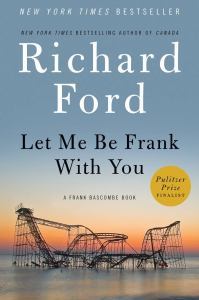 So I picked up Let Me Be Frank With You, his 2014 continuation of the character from Independence Day (and other works), Frank Bascombe.
So I picked up Let Me Be Frank With You, his 2014 continuation of the character from Independence Day (and other works), Frank Bascombe.
Ford is such a master of language that, almost from the start, I was effortlessly pulled into Frank’s world and simply floated along, content to experience things because they were so well told. Joyce Johnson titled her biography of Jack Kerouac The Voice is All, and that’s what I felt about Ford as I read. Like much contemporary literature, his stories were about minor events, all in the wake of Hurricane Sandy. But his way of picking out the relevant details made the stakes of everything feel much larger.
Still, now hyperconscious of the accusations of racism, some things jumped out at me:
“Some Italian piece of shit.”
“A beardless Santa sits on a red plastic milk crate in front of the Launch Pad coffee hut (but he’s clearly a Mexican).”
“My orthopedist at Haddam Medical, Dr. Zippee (a Pakistani and a prime asshole).”
And more on Dr. Zippee:
“…travels back to the old country every winter to work in a Madrassa (whatever that is).”
“I tell him, to me, Pakistanis and Indians are the same people, like Israelis and Arabs, and northern and southern Irishmen. Religion’s just their excuse to main and incinerate each other—otherwise they’d die of boredom.”
And this is all in the first twenty pages.
Is it racist? If not, how else should we read the constant need to refer to members of another culture in apparently disparaging terms, and to stress Frank’s utter, deliberate ignorance of them?
But there’s a deeper question: is it the author’s voice, or the character’s?
If it’s the latter, then perhaps it’s like Archie Bunker was to my parents’ generation: an Everyman whose outdated views are challenged by a shifting world. Certainly Frank, in his continuing adventures through the minutiae of white upper-class American life, is meant to be an Everyman. How “every” that man is, is of course up to each reader to decide.
And yet…
This is the author who spat in the face of an African-American reviewer, and seventeen years later still thinks it was the right thing to do, as he says in his current Esquire piece.
Of course, after Alice Hoffman also once gave him a bad review, he shot up a copy of one of her books and sent it to her. There’s a crucial difference, though. The shooting incident, while equally petty, could still be seen as a response to an equal: “You trashed my book, so I’ll trash yours!” I have to say, I think Rebecca Solnit has the right take on it: there’s no way for a white man to spit in a black man’s face and have it not be a racist act.
Should there be judgment? Consequences? Or, like Harlan Ellison’s epic years of appalling behavior, do we just overlook it because, you know, great writer?
What do you think?



